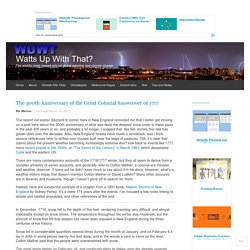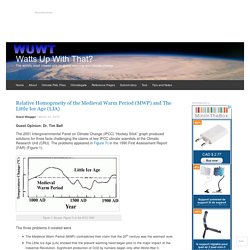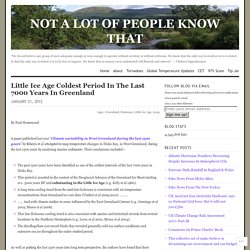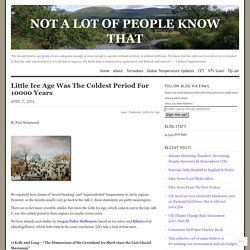

Little Ice Age - Southern Hemisphere. LIttle Ice Age in Europe. Six Ways the Little Ice Age Made History. Share Tweet Email.

The end of the Little Ice Age. The Little Ice Age (LIA) was a recent and significant climate perturbation that may still be affecting the Earth’s climate, but nobody knows what caused it.

In this post I look into the question of why it ended when it did, concentrating on the European Alps, without greatly advancing the state of knowledge. I find that the LIA didn’t end because of increasing temperatures, decreasing precipitation or fewer volcanic eruptions. One possible contributor is a trend reversal in the Atlantic Multidecadal Oscillation; another is an increase in solar radiation, but in neither case is the evidence compelling. There is evidence to suggest that the ongoing phase of glacier retreat and sea level rise is largely a result of a “natural recovery” from the LIA, but no causative mechanism for this has been identified either. Little Ice Age was global: Implications for current global warming. The 300th Anniversary of the Great Colonial Snowcover of 1717. The recent nor’easter (blizzard to some) here in New England reminded me that I better get moving on a post here about the 300th anniversary of what was likely the deepest snow cover in these parts in the past 400 years or so, and probably a lot longer.

I suspect that, like fish stories, this tale has grown taller over the decades. Also, New England forests have made a comeback, and I think several references refer to drifted over houses built near the edge of pastures. Still, it’s clear that claims about the present weather becoming increasingly extreme don’t look back to events like 1717, more recent events in the 1930s, or “The Storm of the Century” in March 1993, which devastated Cuba and the eastern US. There are many contemporary accounts of the 1716/1717 winter, but they all seem to derive from a complex ancestry of earlier accounts, and generally refer to Cotton Mather, a colonial era minister and weather observer. It turns out he didn’t have much to say about it in his diary. Relative Homogeneity of the Medieval Warm Period (MWP) and The Little Ice Age (LIA) Guest Opinion: Dr.

Tim Ball. 1709; The Disparate Economic And Political Impact of Weather And Climate. Guest opinion: Dr.

Tim Ball The Intergovernmental Panel on Climate Change (IPCC) 2001 Report claimed that neither the Medieval Warm Period (MWP) nor the Little Ice Age (LIA) occurred. They created the ‘hockey stick’ graph to prove their point. It wasn’t produced specifically to eliminate those climate periods but to show that today was warmer than “ever” before and that most of the increase occurred in the 20th century.
Little Ice Age Coldest Period In The Last 7000 Years In Greenland. By Paul Homewood A paper published last year “Climate variability in West Greenland during the last 1500 years” by Ribeiro et al attempted to map temperature changes in Disko Bay, in West Greenland, during the last 1500 years by analysing marine sediments.

Their conclusions included :- Little Ice Age Was The Coldest Period For 10000 Years. By Paul Homewood We regularly hear claims of “record breaking” and “unprecedented” temperatures in Arctic regions.

However, as the records usually only go back to the 19th C, these statements are pretty meaningless. Little Ice Age thermometers – History and Reliability. New study – declining temperature and increasing sea ice, combined with lack of adaptation, caused Viking demise in Greenland. We’ve always suspected this for some time, as the MWP ended, they became isolated by the change in weather patterns as the climate turned colder.

Nice to see it in a peer reviewed publication finally. From Wiley-Blackwell Did climate change cause Greenland’s ancient Viking community to collapse? Our changing climate usually appears to be a very modern problem, yet new research from Greenland published in Boreas, suggests that the AD 1350 collapse of a centuries old colony established by Viking settlers may have been caused by declining temperatures and a rise in sea-ice.
Medieval Warm Period And Little Ice Age Show Up In South America Too – Far Far Away From North Atlantic. Dr.

Michael-Shawn Fletcher Based on data from a few carefully selected tree rings, dogmatic warmist scientists like to insist that the Medieval Warm Period really did not exist globally and was only a local North Atlantic phenomenon. The climate, they tell us, was pretty much steady over the last couple thousand years – until man began to prosper a hundred years ago. However, yet another new study, one by Michael Shawn Fletcher and Patricio Iván Moreno, has been published and adds more to the growing mountain of evidence that the Medieval Warm Period was indeed a global phenomenon. Old trees reveal Late Antique Little Ice Age around 1,500 years ago led to famine and social upheavals.
From the Swiss Federal Research Institute WSL: Tree-ring measurements have revealed a period of extreme cold in Eurasia between 536 and around 660 CE.

It coincides strikingly with the Justinian plague, migrations of peoples and political turmoil in both Europe and Asia, reports an interdisciplinary team, led by the Swiss Federal Research Institute WSL and the Oeschger-Zentrum of the University of Bern, in the journal Nature Geoscience. New tree-ring width measurements from the Russian Altai mountains indicate a drastic cold period 1,500 years ago. Credit: Vladimir S. Myglan. Ice freeze data from two lakes suggest warming winters since the end of the Little Ice Age. From York University Citizen scientists collected rare ice data, confirm warming since industrial revolution Torne River, spring 2003 in Tornio. CREDIT Photo by Terhi Korhonen TORONTO, April 26, 2016 – In 1442, Shinto priests in Japan began keeping records of the freeze dates of a nearby lake, while in 1693 Finnish merchants started recording breakup dates on a local river. New geologic evidence of past periods of oscillating, abrupt warming, and cooling. Guest post by Dr.
Don J. Easterbrook, Emeritus Professor at Western Washington University. Little Ice Age thermometers – History and Reliability. Thermometers of the 19th century Image: Wikipedia - click to enlarge This is an excerpt of a larger document by Tony Brown (Tony B on WUWT and other blogs) that he will be happy to make available. He writes: Some months ago I passed you a preliminary study of mine into historic temperatures and their accuracy.
The latest version is attached. Little Ice Age Thermometers- Historic variations in temperatures Part 3 -BEST confirms extended period of warming. Guest post by Tony Brown This short paper is a preliminary examination of BEST data to 1753, as compared to the Central England Temperature Record (CET) to 1660 (instrumental record) and 1538 (Extended by Tony Brown using thousands of contemporary observations) This extension to 1538 was a central part of my article ‘The Long Slow Thaw,’ which also examined historic temperature reconstructions by Dr Michael Mann and Hubert Lamb In the article, warming from the start of the CET instrumental record in 1660 to the present day was noted, albeit with numerous advances and reverses.
The extended CET record coincides well with a 2000 year reconstruction by Craig Loehle here; And one by M. According to studies made by a number of climate scientists, CET is a reasonable proxy for Northern Hemisphere -and to some extent global temperatures- as documented in ‘The Long Slow Thaw’.